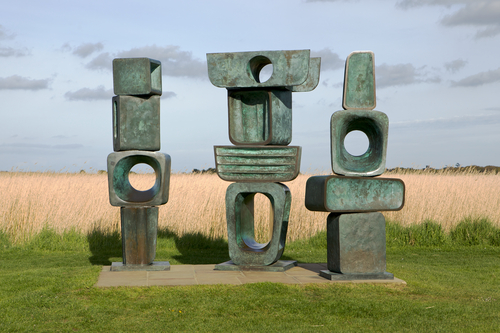Henry Moore rubbished Barbara Hepworth sculpture, diaries say
Revered artist said to have slated rival sculptor’s work when Tate board was considering buying it
He is revered as one of the masters of 20th-century British sculpture, but Henry Moore belittled rival artists while promoting himself within the Tate gallery, according to previously unpublished diaries.
In 1945, the Tate’s board was considering whether to purchase a wooden sculpture by Barbara Hepworth. Moore, then a gallery trustee, interjected with the damning words: “If sculpture [was] nothing more than that, it would be a poor affair.” The ploy worked. The Hepworth was rejected by the board, while every one of seven sculptures the Tate bought that year was by none other than Henry Moore. The incident is recorded in the diaries of John Rothenstein, who headed the Tate for 26 years from 1938.
The “full and chatty” diaries have until now remained largely unseen within the Tate archive, but Rothenstein’s daughter made the material available to Adrian Clark for a book on her father.
Clark writes in his book that the Hepworth sculpture, described by Rothenstein as a “shaft”, would have been a valuable acquisition. Hepworth’s works can now fetch seven-figure sums.
Moore was not the only self-interested artist-cum-trustee, Rothenstein’s diaries show. Another was John Piper, who argued against acquiring works by Pablo Picasso and Henri Matisse and for focusing on British art instead. “Piper’s work was being acquired in spades,” Clark said. “They’re so hypocritical these people. Tate thought it was a great idea having artist-trustees on the board rather than aristocrats.”
Among the trustees in 1945 was Kenneth Clark, a leading authority on Italian Renaissance art who was to write and narrate the landmark BBC series and book Civilisation. Rothenstein’s entry for the acquisitions meeting records that Clark was just as disparaging as Moore of Hepworth’s sculpture, saying that abstract art was a “heresy” and that he doubted whether Tate should admit any of it.
Adrian Clark said that although Rothenstein made mistakes, the Tate director had been unfairly criticised for the gallery’s purchase choices. “He was trapped between the traditionalist attitude … where anything modern was negative, and French-loving art historians who thought anything British was rubbish … But he was dealing with people like Clark and Moore who you’d think would be relatively open to modern art. Even they weren’t. In fact, they were far worse. The artist-trustees were completely viperous.”
Rothenstein was one of Francis Bacon’s early supporters, arranging his first Tate retrospective in 1962. Adrian Clark said: “He [Rothenstein] was fully prepared to like and support modern art if he thought it was good.”
On one occasion, Rothenstein records Bacon saying: “Henry Moore can’t even imagine another contemporary artist being any good.” In another passage, he recorded Bacon bursting into tears on reading the introduction to his exhibition catalogue, saying “it was by far the best thing ever written on him”.
In 1950, Rothenstein wrote of visiting Lucian Freud, describing his studio as “grotesque in its squalor”, adding: “But his work has exquisite and imaginative qualities.” A couple of years later, the board of the Tate bought two Freud pictures. While that decision was supported by Piper, Moore was “cool”, Rothenstein observed in one 1952 entry.

